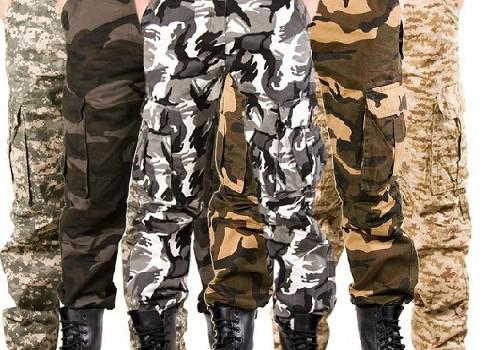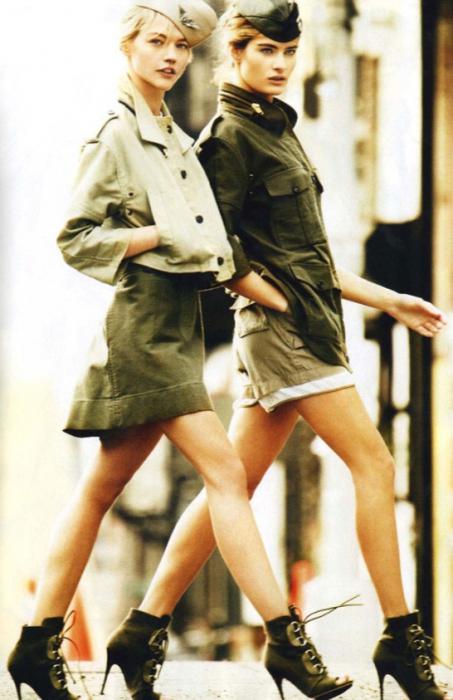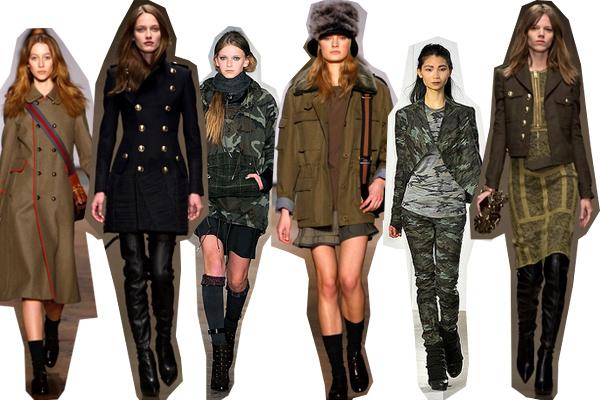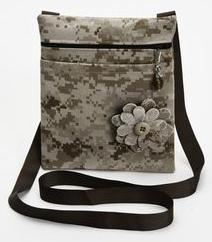The application of protective coloring by mankind has begun recently. At first, masking colors were used only for military purposes. How many lives were saved thanks to a change in the colors of the soldier's uniform to the khaki known today. Now the fabric of protective color has entered into everyday life, and is considered the most practical material.
What is a protective color
This is the common name for flowers that merge with the landscape, nature, and surrounding objects. Objects painted in a protective color go unnoticed in a specific environment.
In some cases, the protective color means the bright color of the entire object or its individual parts, which carries certain information to the safety observer.
Types of protective fabric
Today, there are many varieties of masking fabric. The main differences between them are the background of the protective color and the type of pattern. So, the masking fabric can be monophonic or painted with several colors. In the first case, the color is called "khaki". It can be of different shades: from dirty yellow to gray-green. If the fabric has a specific pattern of swamp flowers, this protective fabric is called camouflage.
Khaki
Protective color is often called another well-known word - khaki. This name is translated from Hindi as "dusty". Khaki denotes the colors of dusty-earthy shades, ranging from dirty yellow to greenish brown.

Camouflage color
Camouflage is a multicolor small- or large-spotted coloration that is used to protect the military, their equipment and weapons from visual recognition by the enemy. As a rule, camouflage is only 2-4-color. Such multi-color significantly distorts the contours of the object, since the color and shape of the picture merges with the surrounding background.
The camouflage pattern is a pattern of spots and stripes of different shapes, applied in a specific order. At the same time, military clothing of protective color is sewn in such a way that the transition of the pattern from one surface to another is preserved.
It should be noted that each army has its own type of camouflage. Thus, the shape and color of the picture can determine where the soldier serves.

How did the protective color of the fabric
The creator of clothes made of swampy fabric is considered the Indian tailor Khaki, in whose honor they called masking colors. He was the first to sew uniforms for English soldiers from swamp mud color material.
According to historical documents, the protective color form was sewn to order by the English Major Hudson, who was fond of drawing before the army. In 1848, he commanded a reconnaissance battalion in India. At that time, soldiers wore a red uniform. Naturally, uniforms of this color were an excellent target for bandits and enemies. Even at a great distance, it was easy to make out soldiers in red uniforms.
A major with creative abilities solved this problem with a non-standard solution - he dressed soldiers in plain-looking costumes, completely invisible against the backdrop of nature. Since the tailor who sewed such a uniform was called Khaki, they decided to name him.
Such changes in the battalion benefited Major Hudson; he quickly rose to the rank of general.
But, unfortunately, the authorities did not support the idea of \u200b\u200bdressing up the army, and sent Hudson to resign for violation of traditions.

Worldwide khaki
After the resignation of Hudson, the military for a while forgot about the protective color. And only half a century later, the British again decided to sew a khaki uniform when the Boer War broke out. The British army was taking such a step after the huge losses of soldiers from sniper fire of enemy shooters.
Then the protective color began to use the Russian army. Having analyzed the results of the Russo-Japanese war, the Russian command was forced to change the uniform of soldiers with white color on the swamp.
During the First World War, the material of protective color was used by the armies of almost all countries of the world. Only the French refused to outfit the soldiers in khaki uniforms, as a result of which they suffered heavy losses. In 1918, the military leaders of France, after long deliberation, nevertheless decided to change their light blue uniforms and multi-colored headdresses to the field form of swamp color.
From that moment, khaki was associated only with the army.

The use of masking colors
Khaki color in various shades is widely used in the military sphere. So, it’s customary to paint the whole military equipment and equipment. Also, tents, backpacks, various cloth household items used by soldiers in the field are sewn from marsh material.
In fact, khaki is used to paint all objects and objects that are used by the military. This coloring allows soldiers to quietly deploy in different territories and easily move in the right directions. The background of the protective color almost merges with nature. And in such circumstances, it is very difficult for a professional to recognize a military man.
According to studies conducted in many countries before the Second World War, the protective "dirty" color makes it difficult to visually highlight an object in almost any area. Only on the untouched snow cover are the soldiers more visible. In this case, additional disguise and a change of clothes to lighter colors are required.
In the modern world, protective paints are used not only in the military industry. Khaki color has found its place in many areas where camouflage from the human and animal eyes is needed. So, swamp-colored clothing is very popular among researchers, archaeologists and tourists. Such an ordinary-looking robe does not attract the attention of others and makes it easy to hide in order to observe nature.

Protective Color Fashion
For half a century, suits of protective color were worn exclusively by the military. And only in the beginning of the 60s the artist Andrew Warhol put on clothes of "dirty" color for an official reception, which shocked the audience. After that, khaki costumes began to gain mass popularity among ordinary citizens.
Fashion designers and designers even created the style of clothes of "dirty" colors and a free cut, known to fashionists under the name "safari". He earned great popularity not only among men. Recently, military-style clothing is increasingly worn by women.
The most interesting thing is that this style has remained relevant for many years. Even this year, well-known designers have developed entire collections of khaki outfits.
In order to keep up with fashion, men and women buy trousers and shirts in protective colors, sew custom-made exclusive clothing in camouflage colors.
In the fashion industry, protective color fabric is mainly used for tailoring suits, trousers and jackets. Very often, the material is used to create tourist equipment.
Khaki - the color of the 21st century
In fact, since the 90s of the last century, all the world's clothing manufacturers have used khaki fabric. Since then, the masking color began to be positioned as the color of freedom and strength. Many countries have begun to create new khaki fabrics that are highly durable and practical.
Today, almost everything is painted in a protective color: bags, wallets, shoes and even mobile phones. Thus, masking colors gradually passed from the armed forces to civilian life. According to stylists, protective color is considered the most popular among men and women.
Khaki military uniform appeared in 1867, during the bloody battle between England and India. The English army in those days was dressed in beautiful, eye-catching uniforms of bright red color, and after one young major saw the number of losses on the battlefield, he realized that the catchy uniform betrays them from head to toe.
After that, in order to reduce the deaths of his fellow soldiers, he decided to order military suits, the color of mud, so that they would not catch the eye and with a large number of pockets from a Hindu tailor. "What's your name, baby?" the major asked the tailor. "Khaki!" - answered the sewing master: “What is translated from Persian as mud.” Hence the name of the color, which has been established and is used to this day. Thanks to his small innovation, the major nevertheless managed to reduce the number of fallen soldiers on the battlefield, he was awarded the rank of general, but, strangely enough, due to non-compliance with great English traditions, he was fired from the army. The complete replacement of the red uniforms with the khaki uniform will be carried out only during the Boer War, when the queen herself, having learned about the losses, ordered a complete replacement of the uniforms in order to reduce the number of losses.
In America, the color "khaki" was used by American paratroopers during the Second World War. When landing in the Ardennes forests that are located in Normandy, the American landing was dressed in clothes of this color. Clothing of the color of mud was used until 1945, after which the soldiers changed into uniforms of a new color. The “hacks" came to replace, which provided greater secrecy during combat or reconnaissance operations.
As it turned out during the Second World War - the color "khaki" is universal and can be used both in the city, in the forest or in the desert. But after the war, color fades into the background and in the sixties they begin to use it in fashion. Cars are repainted and jackets of this color are made.
In the Russian army, before the khaki was introduced, bright, white uniforms were used. After the English innovation, the transfer to the form of color, an analogue of “khaki” in the Russian Empire - protective, passed only after almost twenty years. Soldiers were changed into brand new, beautiful, good quality clothes only in 1908.
There was a transition to clothes of this color after losing in battles at sea against the Japanese army, when the Russian soldiers, in white uniforms, for some reason lost the war, and then Port Arthur.
How did it happen that the great Russian army suffers one defeat after another?
Probably, the point is in their pretty noticeability on the battlefield, and that is why some chiefs decided to replace the uniforms with protective color uniforms. This innovation did not please Russian generals, as did the tsar himself.
The transition to a new uniform was painful, and then the October Revolution began, during which all the greatcoats and tunics that the imperial army sewed became unnecessary, as were the commanders with the command staff. Everyone in the empire was busy redistributing property and revolution, and nobody cared about other things.
During the revolution, the Red Army still dared to sew a new uniform, but since there was a severe shortage of money, as always happens in wartime conditions, this was not possible. The new overcoats were not catchy, they were made of frail fabrics, which were very easy to tear, and did not at all look like military ones. Therefore, the fighters of the Red Army with great pleasure began to wear the royal overcoat of the old model.
By the way, the Russian army in 2008 again adopted a new one, called digital or pixel, replacing camouflage pants and a green spotted tunic that had already become familiar. But, visiting you can choose both spotted tunic and pixel.
Changes in the uniforms of military personnel came in 1917, when new budenovki hats and overcoats of a new kind were introduced, with so-called "talking clasps." These "talkers" were different colors, and he depended on the kind of troops. There were clasps of red, blue and black and it was a good unmasking element. The White Guards very quickly found the target and killed it.
In 1918, it was decided to introduce a new form, which was divided into summer and winter. The color of the overcoats was pale yellow, it became known as the "new protective form of the 1918 sample." On the overcoats, the buttonholes became less noticeable, and also a valve appeared that was very firmly sewn onto the sleeve.
Using this valve, it became very easy to calculate deserters, since it was quite difficult to rip it off, unlike the red star on old-style clothes. As practice has shown, overcoats, jackets and pants did not meet the military conditions of those times. They were oiled, dirty with dirt, blood was spilled on them and all this very much spoiled a very cheap fabric.
Almost immediately, a decision was made to sew expensive, high-quality and, what seems a little strange, foreign military uniforms. As a basis, the French form was taken. But the adoption process was also long and took 5 years. Only in 1924, in the year of the death of V.I. Lenin decided to accept clothes of a new sample.
The tunic, called “French”, was made for commanders, new shirts and pants for the command staff, as well as the newest, lightest hats, far from budenovki, and old, Russian, worn even under the tsar-priest cap.
New shoulder straps, which began to be sewn above the cuffs of the sleeves, also served as an innovation.
The color has not changed much, except for the pilots. They appeared new, black, leather clothes, a blue front door for pilots, as well as a green combined arms.
Thus, by 1940, the Soviet army was fully equipped with new weapons, new outfit sets, but this did not stop the wave of reforms. The first camouflage suits and the first infantry protective equipment began to appear.
Khaki color in clothing is often used in the direction of the military, but it can be found in a glamorous design. The tone often appears on the catwalk in autumn collections.
Where did the concept of hacks come from? Perhaps this word is of Turkic origin, where it means the geographical name of salt marshy pits with a clay crust in the dry season and marshy mud during torrential rains, which are typical for Central Asia and the Lower Volga.
What are the shades of khaki? Where did they come from? Khaki color value. How does khaki in fashion work? What shade of khaki is right for you? Khaki clothing: where appropriate.
The connection of this color with the most destructive power of mankind fills it with confidence, determination and a peculiar shade of omnipotence.
Shades of khaki
Shades of khaki includes a large number of tones: sand, beige, brown, brown-green, dirty green, pale green. This color is closely related to the style of the military, where it has a functional purpose - camouflage. In the desert, the steppe and in any forest, the soldier wants to go unnoticed by the enemy, for this his tone of clothing should merge with the general color of the area. Of course, khaki for the forest and khaki for the desert will be different shades. A huge amount of terrain with different flora requires many shades
Where did the concept of hacks come from? Perhaps this word is of Turkic origin, where it means the geographical name of salt marshy pits with a clay crust in the dry season and marshy mud during heavy rains, which are characteristic of Central Asia and the Lower Volga.
Khaki in Hindi (Indian) means “dusty”. It is believed that the first time khaki camouflage was applied by the British army in India (1867-1868) by an auxiliary unit of local residents.
And from Persian khaki means the color of the earth, which confirms the common root in different languages.
Khaki color value
The connection of this color with the most destructive power of mankind fills it with confidence, determination and a peculiar shade of omnipotence. But this is just a highlight of the scope. The color itself does not have anything aggressive, but vice versa: the natural shades of the earth, dust, dirt, vegetation are the most comfortable tones for the eye. They cause relaxation not only of the eyes, but also of the psyche, coupled with the human vascular system. Khaki lovers tend to be more passive than aggressive. They like not to stand out from the crowd, to have a decent amount of money in a bank account in order to live without poverty and enjoy life. They are not alien to the work routine and constant care for the family.
Like it or not, khaki branches are color with a masculine character. On a woman, he looks like a man’s shirt, which emphasizes the gender difference, enhancing femininity. But it can have another meaning: a tendency to same-sex love.
Among fashion designers there will always be supporters of the middle sex. Trying on a man’s suit for a woman is no new thing for us, and the female military is considered no less sexy than a deep neckline or a mini skirt. In this regard, the military style is always in fashion, and with it the color khaki. Although the color can be separated from the military style and appears on the catwalk in the style of casual, evening dress or glamor.
In nature, this color is more likely to be inherent in summer, but it appears more often in autumn clothing collections, as a confrontation with bad weather.

What shade of khaki will suit you?
All shades of khaki are complex, not bright and multifaceted, but this is the element of the color type.
All brown and greenish shades, including soft sandy ones, are characteristic of the color type. Only frankly yellow shades, without a greenish admixture, should beware.
Representatives of the color type have a complex relationship with khaki: yellowish, greenish and brown shades go "spring", but they must be clean enough not to make her appearance pale.
The brightest and most specific shades of khaki are suitable for the color type, but there are not so many of them.

Khaki clothes
The inconspicuous, calming tones of hacks are good for the city and fit perfectly into the casual style. It is good for traveling around the city in working mode or for relaxing.
Khaki is perfect for the office, and, therefore, for a business uniform. In business negotiations, khaki clothing, on the one hand, indicates your self-confidence, and on the other, about the stability of your character, which is conducive to a deal.
Khaki has both light shades and dark ones. Light is good for summer, dark for cold season.
Khaki, like


